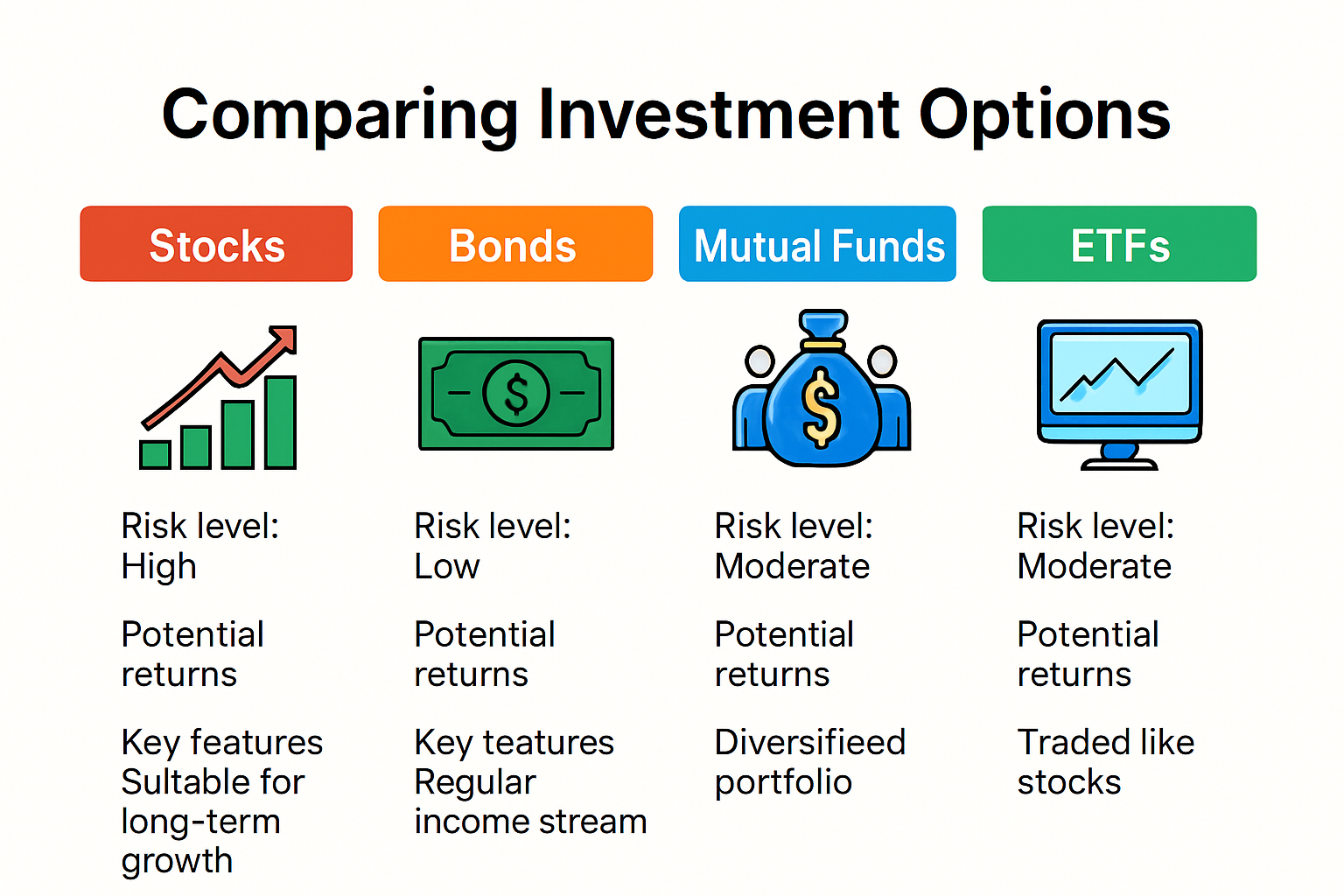So many people want to grow their savings yet find the idea of investing overwhelming or risky. Shocking, right? Even though the average annual return for the S&P 500 over the last 50 years is about 10 percent, most beginners never put their money to work for them. Most people worry about losing money but the bigger risk is missing out on years of steady growth by sitting on the sidelines. The real trick is making investing simple, clear, and built around your actual goals.
Table of Contents
- Understanding Your Investment Goals
- Different Investment Options Explained
- Smart Strategies To Grow Your Money
- Common Mistakes And How To Avoid Them
Quick Summary
| Takeaway | Explanation |
|---|---|
| Set clear investment goals. | Establish specific financial objectives based on your time horizon, resources, and risk tolerance before investing. |
| Diversify your portfolio. | Spread investments across different asset classes and sectors to minimize risk and enhance potential returns. |
| Practice dollar cost averaging. | Invest a fixed amount regularly, regardless of market conditions, to mitigate market timing risks and promote steady growth. |
| Avoid emotional decision-making. | Stick to your investment plan and avoid reactive choices influenced by market fluctuations or emotions like fear and excitement. |
| Review and adjust strategies periodically. | Regularly reassess your portfolio to ensure it aligns with your evolving goals and financial circumstances, adapting as necessary. |
Understanding Your Investment Goals
Successful investing starts with crystal clear goals. Your investment journey is not about randomly throwing money into the market but creating a strategic roadmap that aligns with your financial aspirations and personal circumstances.
Defining Your Financial Objectives
Before diving into investment strategies, you need to establish precise financial objectives. FINRA emphasizes that setting clear investment goals provides critical structure and purpose to your financial planning. These objectives can range from short term needs like building an emergency fund to long term goals such as retirement planning or purchasing a home.
When defining your goals, consider several key factors:
- Time Horizon: How long do you plan to invest? Short term goals (1-3 years) require different strategies compared to long term investments.
- Financial Resources: Assess how much money you can realistically allocate towards investments without compromising your current financial stability.
- Risk Tolerance: Understand your comfort level with potential investment fluctuations.
Matching Investments to Your Goals
The U.S. Securities and Exchange Commission recommends developing a concrete investment plan by asking fundamental questions. What specific financial outcomes do you want to achieve? How much capital do you need to invest to reach these targets? What investment vehicles align best with your objectives?
Different goals demand different investment approaches. A retirement fund might prioritize steady growth and diversification, while a short term savings goal could require more conservative, liquid investments. The North American Securities Administrators Association suggests creating a personal investment plan that includes specific target dates and precise dollar amounts.
Regularly Reassessing Your Investment Strategy
Investment goals are not static. Your financial landscape will change with career progression, life events, and economic shifts. Successful investors treat their investment strategy as a living document that requires periodic review and adjustment.
Schedule annual or bi annual reviews of your investment portfolio. During these assessments, evaluate:
- Whether your current investments are performing as expected
- If your financial goals have shifted
- How changes in your personal circumstances might impact your investment approach
Remember, understanding your investment goals is not a one time exercise but an ongoing process of strategic financial planning. By maintaining clarity, flexibility, and a disciplined approach, you transform investing from a complex challenge into a structured path toward financial growth.
Different Investment Options Explained
Investing is not a one size fits all strategy. Understanding the various investment options available helps you build a robust and diversified portfolio that matches your financial goals and risk tolerance.
Stocks: Ownership in Companies
The U.S. Securities and Exchange Commission provides comprehensive insights into investment products, particularly stocks. Stocks represent ownership shares in publicly traded companies. When you purchase a stock, you become a partial owner of that business and can potentially benefit from two primary ways of earning returns.
- Capital Appreciation: When the company’s value increases, your stock’s market price rises, allowing you to sell at a profit.
- Dividend Payments: Some companies distribute a portion of their profits directly to shareholders as regular cash payments.
Stocks are generally categorized into different types:
- Growth Stocks: Companies expected to grow faster than average market rates
- Value Stocks: Undervalued companies with potential for future growth
- Dividend Stocks: Companies that consistently pay shareholders regular dividends
Bonds: Lending with Fixed Returns
Bonds are essentially loans you provide to governments or corporations. When you purchase a bond, you are lending money in exchange for periodic interest payments and the return of the principal amount at a specified date. Bonds are typically considered more stable compared to stocks.
Key characteristics of bonds include:
- Lower Risk: Generally provide more predictable returns
- Fixed Income: Regular interest payments
- Variety of Types: Government bonds, municipal bonds, corporate bonds
Mutual Funds and Exchange Traded Funds (ETFs)
Mutual funds and ETFs offer an excellent way for beginners to diversify investments without requiring extensive market knowledge. These investment vehicles pool money from multiple investors to purchase a diversified portfolio of stocks, bonds, or other securities.
Mutual Funds:
- Professionally managed by financial experts
- Can be actively or passively managed
- Typically have higher management fees
Exchange Traded Funds (ETFs):
- Trade like individual stocks on exchanges
- Often track specific market indexes
- Generally have lower management expenses
Both mutual funds and ETFs provide instant diversification, reducing the risk associated with investing in individual securities. They allow investors to spread investments across multiple companies and sectors, minimizing potential losses.
Choosing the right investment option depends on your financial goals, risk tolerance, and investment timeline. Beginners should consider starting with a mix of these options, gradually building a balanced portfolio that aligns with their long term financial objectives. Remember that diversification is key to managing investment risk and potentially maximizing returns.

Here is a comparison table summarizing the key features of the main investment options discussed, making it easier to scan their differences and choose the right fit for your financial goals.
| Investment Option | What It Is | Key Features | Typical Risk Level |
|---|---|---|---|
| Stocks | Ownership shares in companies | Capital appreciation, dividends, growth/value types | Higher |
| Bonds | Lending money for fixed returns | Predictable income, lower risk, various issuers | Lower |
| Mutual Funds | Pooled investment managed by experts | Professional management, diversified, higher fees | Moderate |
| ETFs | Pooled, index-tracking, traded on market | Lower fees, instant diversification, like stocks | Moderate |
Smart Strategies to Grow Your Money
Growing your money requires more than just picking random investments. Smart investing demands strategic planning, disciplined approach, and a deep understanding of proven financial techniques that maximize your potential returns while managing risk.
Dollar Cost Averaging: A Consistent Investment Approach
Bankrate recommends dollar cost averaging as an intelligent strategy for beginners. This method involves investing a fixed amount of money at regular intervals, regardless of market conditions. By consistently investing the same amount, you purchase more shares when prices are low and fewer shares when prices are high.
Key benefits of dollar cost averaging include:
- Reduced Market Timing Risk: Eliminates the need to predict market peaks and valleys
- Emotional Discipline: Helps investors avoid reactive decisions based on market fluctuations
- Gradual Investment: Allows systematic building of investment portfolio over time
Portfolio Diversification and Rebalancing
Northwestern Mutual highlights that successful investing requires ongoing optimization and flexibility. Diversification means spreading investments across different asset classes to minimize risk. This strategy ensures that poor performance in one sector does not devastate your entire investment portfolio.
Effective diversification strategies include:
- Asset Allocation: Mix investments across stocks, bonds, real estate, and other asset types
- Sector Diversification: Invest in different industry sectors to reduce concentrated risk
- Geographic Diversification: Consider investments across different global markets
Periodic portfolio rebalancing helps maintain your desired asset allocation. This involves selling overperforming assets and purchasing underperforming ones to maintain your original investment strategy.
Long Term Buy and Hold Strategy
Nasdaq’s Smart Investing guide emphasizes the power of a long term investment approach. The buy and hold strategy involves selecting quality investments and maintaining them for extended periods, allowing compound growth and minimizing transaction costs.
Key principles of the buy and hold strategy:
- Patience: Resist impulse selling during short term market fluctuations
- Quality Selection: Choose investments with strong fundamental value
- Minimal Trading: Reduce frequent buying and selling to lower transaction expenses
Successful investors understand that wealth creation is a marathon, not a sprint. By implementing these smart strategies consistently, you transform investing from a complex challenge into a structured path of financial growth. Remember that every investment decision should align with your personal financial goals, risk tolerance, and time horizon.
The most powerful investment strategy combines disciplined approach, continuous learning, and adaptability. Stay informed, remain patient, and focus on long term financial objectives rather than short term market noise.

Common Mistakes and How to Avoid Them
Investing can be a challenging journey filled with potential pitfalls. Understanding and avoiding common investment mistakes can significantly improve your financial outcomes and protect your hard earned money.
Emotional Decision Making
The Indonesian Ministry of Finance warns about the dangers of making impulsive investment decisions driven by emotions. Panic selling during market downturns or jumping into investments based on fear or excitement can seriously damage your long term financial strategy.
Common emotional traps include:
- Panic Selling: Rushing to sell investments when markets decline
- FOMO Investing: Making hasty investments due to fear of missing out
- Overconfidence: Believing you can consistently predict market movements
To combat emotional investing, develop a disciplined approach:
- Create a clear investment plan and stick to it
- Set predetermined rules for buying and selling
- Avoid checking your investments too frequently
- Focus on long term goals rather than short term fluctuations
The following table summarizes some common emotional investment mistakes and practical strategies to avoid them, helping new investors make more rational decisions.
| Emotional Mistake | Description | How to Avoid |
|---|---|---|
| Panic Selling | Selling investments in fear during market declines | Stick to your plan |
| FOMO Investing | Jumping into investments due to fear of missing out | Set clear buying rules |
| Overconfidence | Belief in ability to consistently predict markets | Follow disciplined approach |
| Checking Too Often | Frequent portfolio checks leading to anxiety | Limit checking, focus on goals |
| Impulsive Decisions | Reacting to short-term market fluctuations | Focus on long-term objectives |
Market Timing Misconceptions
Nasdaq highlights that attempting to time the market is one of the most dangerous strategies for new investors. Trying to perfectly predict market peaks and valleys is nearly impossible, even for professional financial experts.
Instead of market timing, focus on:
- Consistent Investing: Regular contributions regardless of market conditions
- Dollar Cost Averaging: Investing fixed amounts at regular intervals
- Long Term Perspective: Maintaining investments through market cycles
Lack of Clear Financial Goals
The U.S. Securities and Exchange Commission emphasizes the critical importance of setting clear financial objectives before investing. Without specific goals, investors often make random, unfocused investment decisions that fail to support their broader financial strategy.
Key steps to establish clear investment goals:
- Define specific financial targets
- Determine exact time frames for achieving these goals
- Assess your risk tolerance
- Create a structured investment plan that aligns with your objectives
Additional mistakes to avoid include:
- Neglecting to diversify your investment portfolio
- Overlooking investment fees and expenses
- Failing to regularly review and rebalance investments
- Investing money you cannot afford to lose
Successful investing requires a combination of knowledge, discipline, and patience. By understanding these common mistakes and implementing strategic approaches, you can build a more robust and resilient investment strategy. Remember that investing is a journey of continuous learning. Stay informed, remain calm, and focus on your long term financial objectives.
The most successful investors are those who develop a disciplined approach, learn from their mistakes, and maintain a consistent, well thought out strategy.
Frequently Asked Questions
What are the first steps to start investing money wisely?
Start by defining your financial goals, assessing your time horizon, and understanding your risk tolerance. Create a clear investment plan that aligns with these objectives, and consider diversifying your portfolio with a mix of stocks, bonds, mutual funds, and ETFs.
How can I reduce the risks associated with investing?
You can reduce risks by diversifying your investments across different asset classes and sectors. Implementing strategies such as dollar cost averaging and regularly rebalancing your portfolio can also help manage risk effectively.
What is dollar cost averaging, and why is it beneficial?
Dollar cost averaging involves investing a fixed amount of money at regular intervals, regardless of market conditions. This strategy helps mitigate market timing risks and allows you to purchase more shares when prices are low, promoting steady growth over time.
How often should I review my investment strategy?
It’s important to review your investment strategy at least annually or bi-annually. During these reviews, assess your portfolio’s performance, evaluate any changes in your financial goals, and adjust your investment approach as necessary based on your evolving circumstances.
Turn Investment Confidence Into Real Results With Professional Guidance
Feeling overwhelmed by the risks of investing or unsure if you are building the right strategy for your financial goals? Many new investors struggle to avoid emotional mistakes like panic selling, choosing the wrong assets, or missing out on steady growth because they lack a clear, guided plan. Our article explained the importance of setting investment goals, using strategies like dollar cost averaging, and checking your progress regularly. Now, if you want to take the next step from theory to real progress, expert support makes all the difference.

Let the lessons you learned today become actions that grow your wealth. Connect with the financial consultants at finblog.com for personal tips targeted to your time horizon, risk tolerance, and investment objectives. Fill out our secure, simple information form on our home page to start your journey from uncertainty to clarity. Now is your moment to invest with confidence and avoid the mistakes that keep beginners stuck in place. Schedule a free consultation today and transform smart investing knowledge into your own financial success.










